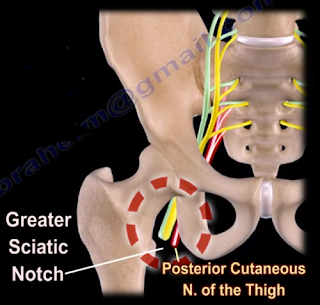The posterior cutaneous nerve of the thigh (small sciatic
nerve) arises from the sacral plexus from S1-S3. The posterior cutaneous nerve
of the thigh exits from the pelvis through the greater sciatic notch below the
piriformis muscle. The nerve descends below the gluteus maximus muscle along
with the inferior gluteal artery. It runs into the back of the thigh beneath
the fascia lata and over the long head of the biceps femoris muscle to the back
of the knee. The nerve then pierces the deep fascia and accompanies the short
saphenous vein to the middle of the back of the leg. The posterior cutaneous
nerve of the thigh innervates the distal part of the gluteal region, the skin
of the perineum and the posterior part of the thigh.
 The nerve can become compressed
when passing through the tunnel below the piriformis muscle and under the
gluteus maximus muscle. This may result in sensitivity disturbances of the
innervation area of the nerve. Causes of the syndrome may be hypertrophy or
abnormality of the piriformis muscle such as entrapment below the piriformis
which compresses the nerve. Compression of the nerve can also occur due to
prolonged sitting. During the clinical examination, pain and sensitivity will
be evident. Pain and sensitivity disturbances are characteristic of the nerve
distribution site in the posterior part of the thigh down the knee. This
disturbance can be from hyperesthesia to hypoesthesia or burning sensation
similar to meralgia paresthetica of the lateral cutaneous nerve of the thigh.
The nerve can become compressed
when passing through the tunnel below the piriformis muscle and under the
gluteus maximus muscle. This may result in sensitivity disturbances of the
innervation area of the nerve. Causes of the syndrome may be hypertrophy or
abnormality of the piriformis muscle such as entrapment below the piriformis
which compresses the nerve. Compression of the nerve can also occur due to
prolonged sitting. During the clinical examination, pain and sensitivity will
be evident. Pain and sensitivity disturbances are characteristic of the nerve
distribution site in the posterior part of the thigh down the knee. This
disturbance can be from hyperesthesia to hypoesthesia or burning sensation
similar to meralgia paresthetica of the lateral cutaneous nerve of the thigh.
Differential diagnosis include piriformis syndrome. The
patient should avoid sitting for long periods of time, especially on a hard
base. Treatment consists of physical therapy, massage, and injection. Surgery
is rarely needed.
